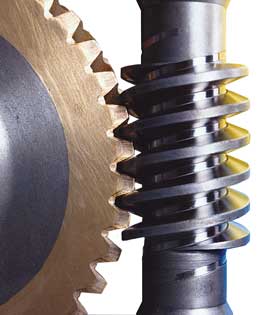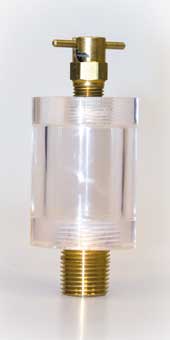Gear Alignment Affects Lubrication

Worm gearing alignment affects lubrication. If the worm is located off the worm gear centerline, there may be entering corner contact. This wipes the lubricant off the worm gear teeth and the worm thread like a squeegee, causing the mesh to be starved for lubricant. The resulting wear is progressive and almost always leads to the need to replace both the worm and the worm gear. An easy way to prevent this type of failure is to perform a contact pattern check when the worm gear and worm are installed or being replaced. Most texts on worm gearing show both acceptable and unacceptable contact patterns for this unloaded condition. If in doubt, contact the worm gear drive vendor or the drive manufacturer.
Oil analysis would show this condition as high levels of copper from the worm gear. The copper levels will increase over time rather than decrease, as is the case for normal break in. Visual inspection would show wear on the worm gear tooth from the tip to the root at the edge of the tooth that sees the thread entry into mesh. There may also be a transfer of bronze from the worm gear to the worm thread.

Rule of Thumb for Selecting Oils
The pour point is the lowest temperature at which an oil will flow. This property is crucial for oils that must flow at low temperatures. A commonly used rule of thumb when selecting oils is to ensure that the pour point is at least 10 degrees C (20 degrees F) below the lowest anticipated ambient temperature.
How to Store and Preserve Parts
Try using a vacuum-packaging unit (the kind used for storing food for freezing) to help with parts storage and preservation. This quick and simple method can be utilized to keep items clean and dry. Parts can be sealed in plastic, with a desiccant bag for good measure. It can also be used to keep small parts organized until they are needed, such as a matched set of coupling bolts, springs or electronic parts.
Sight Gauge Simplifies Inspection
Consider adding a vertical sight gauge to critical gearboxes that are not fitted with a dipstick or a sight glass, where the only way to check the oil level is to take out the level plug.
Fitting a sight gauge allows the oil to be checked on the run and can indicate the oil level even if the gearbox is mounted in an unusual orientation. However, there are some important points to remember: First, fit the gauge to a low point (preferably the drain) and not the level plug, as you could overfill the box. Second, to avoid mistakes, mark the static level and the running level on the gauge. Third, make sure the gearbox has a breather. Otherwise, a partial vacuum could be set up, also giving a false reading.

Advice for Tracking Oil
Loss If you decide to implement a program to control oil losses, one of the first steps you should take is to check records of the amount purchased compared with the amount sent for disposal. Try to account for the difference by looking for leaks, products consumed in the process, evaporative losses and products wasted due to contamination or misapplication.
